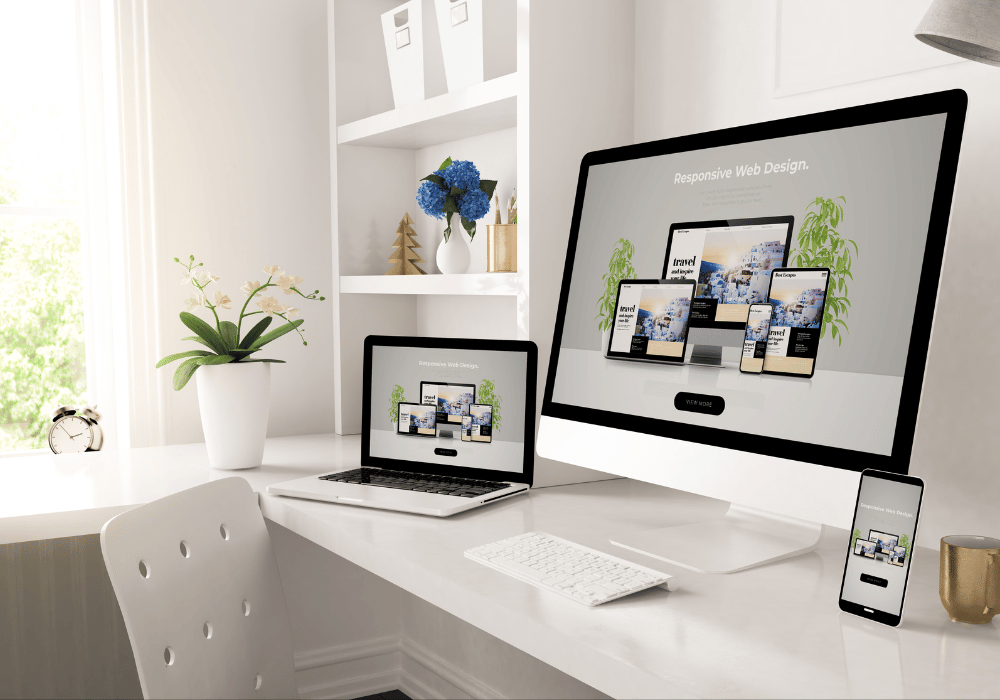How Modern Web Design Drives Higher Conversion Rates

Your website is often the first interaction potential customers have with your business. Modern web design goes beyond aesthetics—it’s a strategic tool that helps convert casual visitors into paying customers. By integrating responsive layouts, optimizing user experiences (UX), and enhancing visual appeal, businesses can create a seamless pathway toward higher conversion rates. This guide explores the key elements of modern web design and how they directly impact website performance and business success.
Responsive Design Enhances Accessibility
 Responsive design ensures your website looks great and operates smoothly across all devices, from desktops to smartphones. This flexibility is no longer optional, as mobile traffic accounts for a significant portion of web interactions. A site that adapts to various screen sizes without compromising functionality is far more likely to keep visitors engaged, reducing bounce rates and boosting conversions.
Responsive design ensures your website looks great and operates smoothly across all devices, from desktops to smartphones. This flexibility is no longer optional, as mobile traffic accounts for a significant portion of web interactions. A site that adapts to various screen sizes without compromising functionality is far more likely to keep visitors engaged, reducing bounce rates and boosting conversions.
When users encounter a non-responsive site, frustration often follows—buttons are too small to click, images are cropped, and text is difficult to read. Such experiences can push users to abandon your site in favour of a competitor’s mobile-friendly design. On the other hand, responsive sites provide intuitive navigation and optimal display, encouraging users to explore further and complete actions like signing up for newsletters or making purchases.
Additionally, responsive design positively affects search engine optimization (SEO). Google prioritizes mobile-friendly websites in search rankings, meaning a responsive site can improve visibility. The increased traffic and improved user retention that follow are key ingredients for driving conversions.
User Experience (UX) Converts Visitors into Customers
An effective website doesn’t just attract visitors; it guides them effortlessly toward desired actions. User experience (UX) design focuses on creating intuitive, enjoyable, and functional pathways that lead users to your conversion goals. From a clear site structure to strategic call-to-action placements, excellent UX design fosters trust and confidence in your brand.
Navigation is one of the cornerstones of good UX. Visitors shouldn’t have to search long and hard to find the information they need. Simple menus, strategically placed search bars, and quick-loading pages all contribute to a user-friendly experience. Studies show that visitors are more likely to take action on a site where they can find what they’re looking for in three clicks or less.
Another critical component of UX is page speed. Slow-loading sites significantly hinder engagement, with data revealing that a delay of just one second can decrease conversion rates by up to 7%. By optimizing images, using modern coding practices, and leveraging content delivery networks (CDNs), businesses can ensure their websites load quickly and keep users engaged.
Visual Appeal Impacts First Impressions
First impressions matter, and nowhere is this truer than in web design. Visitors form an opinion about your website within milliseconds of landing on it, long before they’ve had a chance to read your content or explore your services. Modern web design uses high-quality visuals, clean layouts, and consistent branding to create an engaging and professional image that builds credibility.
Colour palettes, typography, and imagery play a major role in how visitors perceive your site. Different colours evoke different emotions, and choosing the right palette can subtly influence user behaviour. For example, green is often associated with prosperity and trust, making it a popular choice for financial services websites. Similarly, font styles and their legibility impact how users interact with written content. Cluttered or inconsistent design creates confusion and discourages action, but a polished look communicates professionalism.
Beyond aesthetics, visual design influences user journeys. Eye-catching buttons, banners, and product images guide visitors toward conversion-boosting areas such as contact forms or ecommerce pages. Dynamic elements like animations or interactive features can also hold users’ attention longer, increasing the likelihood of engagement.
Content Optimization Encourages User Interaction
 A successful modern website doesn’t just look good; it delivers value through high-quality content optimized for both users and search engines. Clear, concise messaging is essential for helping visitors quickly understand why your product or service stands out. Content should align with user intent and guide them toward specific actions.
A successful modern website doesn’t just look good; it delivers value through high-quality content optimized for both users and search engines. Clear, concise messaging is essential for helping visitors quickly understand why your product or service stands out. Content should align with user intent and guide them toward specific actions.
Headers and subheaders improve readability while emphasizing key points on the page. Engaging headlines paired with well-designed font hierarchies ensure no important information goes unnoticed. Likewise, well-written product descriptions or service information provide answers to user questions and reduce the likelihood of hesitation.
Content optimization also involves integrating your primary keyword into strategic locations, such as headings, body text, and meta descriptions. When paired with effective copywriting, SEO-friendly content improves site visibility and ensures that valuable traffic reaches your site organically, leading to more conversions.
Trust Signals Build Confidence
Online visitors are naturally cautious, especially when considering a purchase or inquiry. Incorporating trust signals into your web design can alleviate uncertainties and build the credibility necessary to win conversions. These signals can take the form of customer testimonials, certifications, or secure checkout badges.
Displaying real reviews or case studies demonstrates that other individuals or businesses have benefited from your products or services. Including photos or videos with testimonials makes them even more credible. Certifications or accreditations from recognized industry authorities further assure customers that they are dealing with a reputable business.
Secure payment gateways and visible privacy policies reassure visitors who are wary about sharing sensitive information. Trust signals help establish a connection, making visitors feel safe and confident enough to complete their desired action, whether it’s making a purchase or filling out a form.
Analytics Integration for Continuous Improvement
What happens if your web design efforts aren’t producing the results you anticipated? That’s where analytics integration comes in. Applying data-driven insights to your web design ensures continuous improvement and higher conversion rates over time.
Website analytics tools such as Google Analytics or heatmaps give you valuable insights into user behaviour. You can track metrics like time spent on each page, conversion path performance, and bounce rates to identify design elements that are working and areas that need improvement. For example, analytics may reveal that users drop off at a specific step in your checkout process. Using this data, you can redesign that element to facilitate smoother conversions.
A/B testing is another method for optimization. By tweaking small elements, such as button colours, headlines, or image layouts, businesses can test different versions of their website to determine what resonates best with their audience. This iterative process leads to long-term improvements in site performance.
Modern web design is about much more than aesthetics—it’s a strategic tool for driving conversions. A responsive design ensures accessibility across all devices, while UX enhancements and visual appeal guide visitors toward desired actions. Trust signals build confidence, content optimization engages users, and analytics-backed improvements ensure sustained success.
If your website isn’t delivering the conversions you need, SlyFox Web Design & Marketing can help. Our expert team specializes in designing websites that not only look great but also deliver measurable results. Contact us today to learn how we can transform your site into a powerful conversion-driving tool.